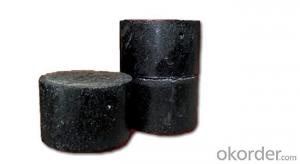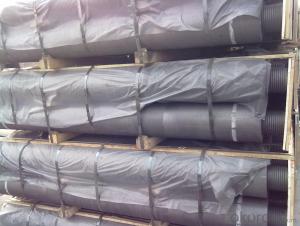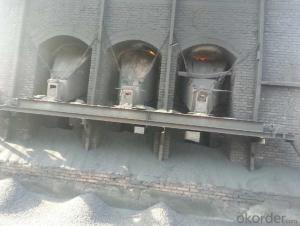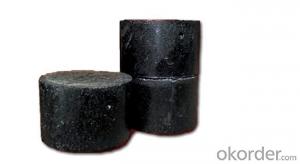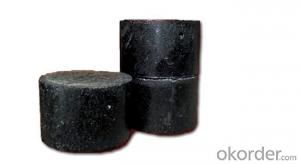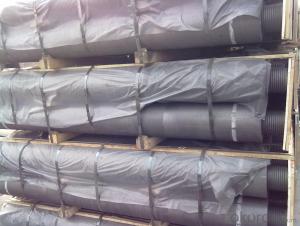cylinder Carbon Electrode Paste with DIA 500-600mm
- Loading Port:
- Lianyungang
- Payment Terms:
- TT OR LC
- Min Order Qty:
- 20 m.t.
- Supply Capability:
- 20 m.t./month
OKorder Service Pledge
OKorder Financial Service
You Might Also Like
Spcifications
1:carbon eletrode paste
2:for ferroalloy,calcium carbide manufacture
3:HS 3801300000,YB/T5212-1996,ISO9001:2008
Product Description
Carbon Electrode Paste is a self-baking electrode used in submerged arc furnaces for delivering power to the charge mix. Electrode Paste is added to the top of the electrode column in either cylindrical or briquette form. As the paste moves down the electrode column the temperature increase causes the paste to melt and subsequently bake forming a block of electrically conductive carbon. Electrode Paste is essentially a mix of Electrically Calcined Anthracite (ECA) or Calcined Petroleum Coke (CPC) with Coal Tar Pitch.
Graphite/Carbon Electrode Paste Specification:
| PARAMETER UNIT GUARANTEE VALUE | ||||||
| Ash.( % ) | 4.0 max | 5.0 max | 6.0 max | 7.0 max | 9.0 max | 11.0 max |
| V.M (%) | 12.0-15.5 | 12.0-15.5 | 12.0-15.5 | 9.5-13.5 | 11.5-15.5 | 11.5-15.5 |
| Compress Strength. | 18.0 min | 17.0 min | 15.7 min | 19.6 min | 19.6 min | 19.6 min |
| Specific Resistance | 65 max | 68 max | 75 max | 80 max | 90 max | 90 max |
| Bulk Density | 1.38 min | 1.38 min | 1.38 min | 1.38 min | 1.38 min | 1.38 min |
Picture:
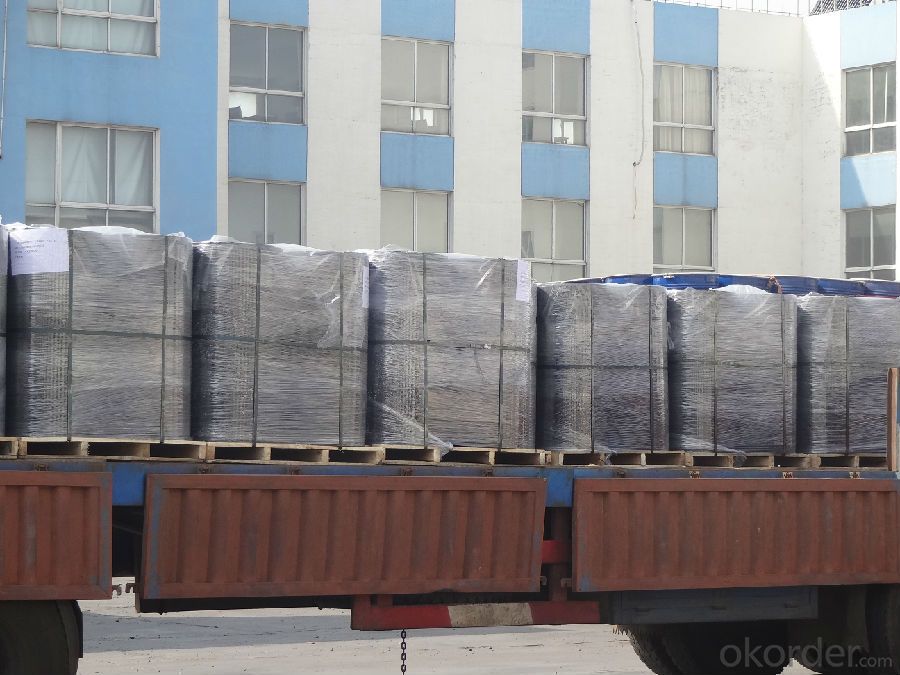
- Q: How does carbon contribute to global warming?
- Carbon contributes to global warming through the greenhouse effect. When carbon dioxide (CO2) and other greenhouse gases are released into the atmosphere, they trap heat from the sun and prevent it from escaping back into space. This leads to an increase in the Earth's surface temperature, causing global warming. The primary source of carbon emissions is the burning of fossil fuels such as coal, oil, and natural gas for energy production, transportation, and industrial processes. These activities release large amounts of CO2 into the atmosphere, which accumulates over time and enhances the greenhouse effect. Additionally, deforestation and land-use changes also contribute to rising carbon levels. Trees and plants absorb CO2 as part of photosynthesis, acting as a natural carbon sink. However, when forests are cleared, this stored carbon is released back into the atmosphere. Moreover, the loss of trees reduces the overall capacity to absorb CO2, exacerbating the problem. The consequences of increased carbon emissions are far-reaching. Rising temperatures result in the melting of polar ice caps and glaciers, leading to sea-level rise and threatening coastal communities. Furthermore, carbon-driven global warming disrupts weather patterns, causing extreme weather events such as hurricanes, droughts, and heatwaves. To mitigate the impact of carbon on global warming, efforts must be made to reduce carbon emissions. This can be achieved through transitioning to renewable energy sources like solar and wind, improving energy efficiency, promoting sustainable practices in agriculture and forestry, and implementing policies that encourage carbon capture and storage. Addressing carbon emissions is crucial in combating global warming and its associated consequences. By understanding the role of carbon in the greenhouse effect, we can work towards a sustainable future that minimizes the harmful effects of climate change.
- Q: What are the impacts of carbon emissions on the stability of mountain glaciers?
- Carbon emissions have a significant impact on the stability of mountain glaciers. As carbon dioxide and other greenhouse gases accumulate in the atmosphere, they trap heat and contribute to global warming. This increase in temperature leads to accelerated melting of mountain glaciers, reducing their size and volume. The loss of glaciers not only affects the availability of freshwater resources but also disrupts local ecosystems, alters river flows, and poses a risk of glacial lake outburst floods. Moreover, melting glaciers contribute to rising sea levels, which can have far-reaching consequences for coastal communities and low-lying areas. Therefore, reducing carbon emissions is crucial to mitigate the adverse effects on the stability of mountain glaciers and preserve these vital natural resources.
- Q: How does carbon contribute to the flavor of food?
- Carbon, in the form of charcoal or charred substances, can contribute to the flavor of food in several ways. Firstly, when food is grilled or roasted over charcoal, the carbon imparts a smoky flavor to the food, enhancing its taste and aroma. This smokiness is particularly desirable in foods like barbecued meats, vegetables, or even certain cheeses, as it adds a distinct and enjoyable element to the overall flavor profile. Furthermore, carbon can also act as a natural filter, absorbing and removing impurities from food and beverages. This filtration process can help eliminate unpleasant odors and flavors, resulting in a cleaner and more refined taste. For example, activated carbon is commonly used in the production of alcoholic beverages like whiskey or vodka to remove impurities and create a smoother, more flavorful drink. In addition, carbon can contribute to the development of desirable texture and color in certain foods. When sugar or other carbohydrates are heated, they undergo a process called caramelization, where the sugars react with heat to form a complex mixture of carbon compounds. This caramelization process creates rich, golden-brown hues and a unique depth of flavor, enhancing the overall taste experience. Lastly, carbon can also play a role in the fermentation process, which is essential in the production of various foods and beverages. During fermentation, microorganisms consume sugars and release carbon dioxide, which contributes to the texture, flavor, and carbonation of the final product. This is particularly evident in bread, beer, wine, and other fermented foods where the presence of carbon dioxide adds lightness, complexity, and effervescence to the flavor profile. In summary, carbon contributes to the flavor of food through its ability to impart smokiness, act as a natural filter, facilitate caramelization, and participate in fermentation processes. Its presence in various forms enhances the taste, texture, and overall enjoyment of a wide range of food and beverages.
- Q: Is badminton all good as carbon or aluminum carbon? Does carbon fiber on the Internet mean total carbon?
- The badminton racket is different in texture. Mainly divided into titanium, carbon, aluminum, carbon fiber, aluminum alloy and pure iron, pure aluminum. Among them, the best material is titanium, followed by carbon, aluminum, carbon fiber, aluminum alloy and pure iron, pure aluminum. Related knowledge: before 70s, the material is almost entirely of wood and steel in the world, in 70s began to use Aluminum Alloy, now the world is completely new materials such as carbon fiber, titanium alloy, high strength carbon fiber and other materials because they are lighter, stronger, more durable and can absorb more vibration and shock, at the same time let the racket maker the hardness of the racket, ball, have more space to play ball on the performance design. When choosing the racket, best to look at this is what a racket made of material, usually in the racket racket rod and a racket frame will be labeled with the material, sometimes is the same as YONEX ISO-800TOUR High Modulus Graphite shot rod (high strength carbon fiber) frame also has the same mark, and some racket racket rod and frame material is not the same as: YONEX ISO-250LONG High Moudulus Graphite shot frame for Graphite (carbon fiber). Some also took pole, beat box made of the same material the labeled All Graphite or All Graphite racket only in a local frame or shaft. Sign formal products are accurate and reliable, and fake products marked is printed, it is generally used in relatively poor carbon cloth, compared the density, purity and regular products so large that the cost is very low.
- Q: What is carbon dioxide?
- Comprising carbon and oxygen atoms, carbon dioxide (CO2) is an odorless and colorless gas. Its formation stems from the combustion of fossil fuels, respiration, and volcanic activity. In the Earth's atmosphere, carbon dioxide serves as a crucial greenhouse gas, effectively trapping heat and impacting the planet's overall temperature. Although it occurs naturally, human actions, such as burning fossil fuels and deforestation, have significantly escalated its presence in the atmosphere, consequently leading to global warming and climate change. Additionally, carbon dioxide is a byproduct of diverse industrial processes, including cement production and power generation. Thus, reducing carbon dioxide emissions is paramount to mitigating the consequences of climate change and preserving a sustainable environment.
- Q: What is carbon capture and storage?
- The aim of carbon capture and storage (CCS) technology is to lessen carbon dioxide (CO2) emissions from major sources like industrial processes, power plants, and others. It works by capturing CO2 emissions before they are released into the atmosphere and then storing them securely underground. To capture carbon, specialized equipment is typically used to trap CO2 from flue gases or industrial processes. The captured CO2 is then compressed and transported through pipelines or ships to a suitable storage site located deep underground. These storage sites can include depleted oil and gas fields, saline aquifers, or deep coal seams. The storage process ensures long-term containment of CO2 and reduces the risk of leakage. This is achieved by monitoring the storage site for signs of leakage, maintaining the integrity of the storage infrastructure, and selecting suitable sites with geological features that aid in long-term CO2 containment. Carbon capture and storage has the potential to greatly reduce CO2 emissions and contribute to climate change mitigation. By capturing and storing CO2 instead of releasing it into the atmosphere, industries can continue using fossil fuels while minimizing their environmental impact. This is particularly beneficial for industries that are challenging to decarbonize, such as cement production, steel manufacturing, and natural gas power plants. Despite its promise, the widespread implementation of carbon capture and storage faces challenges and limitations. One significant challenge is the high cost associated with establishing CCS infrastructure and operations. Additionally, finding suitable storage sites and addressing public concerns about the safety and environmental impact of underground CO2 injection can pose significant obstacles. Nevertheless, carbon capture and storage is considered an essential tool in the battle against climate change. It can play a crucial role in achieving global emission reduction goals and transitioning to a low-carbon economy. With advancing technology and decreasing costs, the widespread adoption of carbon capture and storage may become increasingly feasible and necessary.
- Q: What is carbon dating and how does it work?
- The age of organic materials, like wood, cloth, and bone, can be determined using carbon dating, a scientific method. This method measures the quantity of carbon-14 (C-14) present in the sample. It is based on the principle that all living organisms contain a small amount of radioactive carbon-14, which is created in the upper atmosphere when nitrogen atoms are hit by cosmic rays. Over time, this radioactive form of carbon decays and transforms into nitrogen-14. To begin the process of carbon dating, a sample is collected from the object of interest. Typically, this sample consists of organic matter that was once part of a living organism. The sample is then treated to remove any impurities and made ready for analysis. Scientists measure the ratio of C-14 to stable carbon-12 (C-12) in the sample to determine its age. This measurement is carried out using an accelerator mass spectrometer (AMS), an instrument with high sensitivity that can detect and measure extremely low levels of C-14. By comparing the ratio of C-14 to C-12 in the sample with the known ratio in the atmosphere at the time the organism died, scientists can calculate the time that has passed since the organism's death. The half-life of C-14, which is the time it takes for half of the radioactive isotope to decay, is approximately 5,730 years. This means that after 5,730 years, half of the C-14 in a sample will have transformed into nitrogen-14. By measuring the remaining amount of C-14 in a sample and knowing its half-life, scientists can estimate its age. Carbon dating is an invaluable tool for archaeologists, paleontologists, and geologists as it enables them to accurately determine the age of ancient artifacts, fossils, and geological formations. However, it is important to note that carbon dating is effective only for materials up to around 50,000 years old since beyond this point, the remaining amount of C-14 becomes too small to measure accurately.
- Q: What are carbapenem antibiotics?
- Commodity name: Thai, times, speed, energy, spectrum, and G times Roarke Meiping Shu Ning
- Q: What is carbon monoxide poisoning?
- Carbon monoxide poisoning is a potentially deadly condition that occurs when an individual inhales or is exposed to high levels of carbon monoxide gas. Carbon monoxide is a colorless, odorless, and tasteless gas that is produced from the incomplete combustion of carbon-based fuels such as gasoline, natural gas, coal, and wood. When carbon monoxide is inhaled, it enters the bloodstream and binds to hemoglobin, the molecule responsible for carrying oxygen throughout the body. This binding process prevents oxygen from being adequately delivered to vital organs and tissues, leading to oxygen deprivation or hypoxia. The symptoms of carbon monoxide poisoning can vary depending on the level and duration of exposure, but they often resemble those of the flu, including headache, dizziness, weakness, nausea, vomiting, confusion, and loss of consciousness. Prolonged exposure to high levels of carbon monoxide can result in severe brain damage, organ failure, and even death. It is crucial to take immediate action if carbon monoxide poisoning is suspected. This includes removing oneself from the source of exposure, seeking fresh air, and contacting emergency services for medical attention. Additionally, it is essential to identify and address the source of carbon monoxide, such as faulty heating systems, blocked chimneys, or malfunctioning appliances, to prevent further exposure and ensure the safety of the environment. Prevention is key in avoiding carbon monoxide poisoning. Regularly maintaining and inspecting fuel-burning appliances, installing carbon monoxide detectors in homes and buildings, and ensuring proper ventilation are vital steps to minimize the risk of exposure. Education and awareness about the dangers of carbon monoxide and the necessary precautions can help save lives and protect individuals from this silent killer.
- Q: Is there a line cutting of carbon fibers?
- Your question is not clear. Do carbon fibers need to be cut with wire? Are carbon fiber composites? What type? In general, carbon fiber reinforced composites can not be cut by wire. They can be cut by ultrasonic and water cut
Send your message to us
cylinder Carbon Electrode Paste with DIA 500-600mm
- Loading Port:
- Lianyungang
- Payment Terms:
- TT OR LC
- Min Order Qty:
- 20 m.t.
- Supply Capability:
- 20 m.t./month
OKorder Service Pledge
OKorder Financial Service
Similar products
Hot products
Hot Searches
Related keywords
